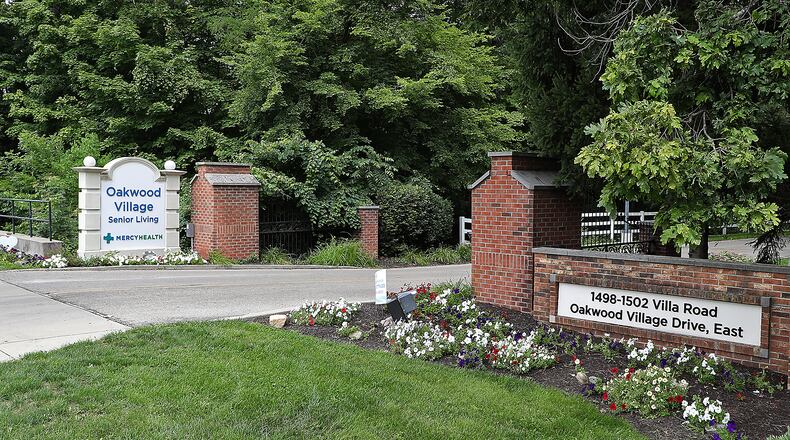Clark County had 1,394 cases, 25 deaths and two probable deaths of the coronavirus as of Friday afternoon, according to the Ohio Department of Health.
In the first five months of the pandemic, between March and July, the county recorded 14 total deaths, according to CCCHD data. Between Aug. 16 and Aug 26, the county recorded 13 deaths, a near 50% increase in total deaths.
“The last 10 days have not been kind to Clark County at all,” Patterson said.
Of the 27 total deaths, nearly half, or 16, have come from residents of long-term care facilities. In Clark County, the average age of those who have died of COVID-19 is 76, according to data from the CCCHD.
Patterson said the county is currently experiencing COVID spread throughout the community, infecting long-term care facility staff who are unknowingly bringing the virus to work.
“The issue is people are asymptomatic. I get this question a lot, you know, why is this still an issue if employees get tested every week. Well, they get tested every week, yes, but if I get exposed yesterday, or the day before yesterday, and I get tested today, it’s not going to show up,” Patterson said. “Then, ten days later, maybe I test positive but I was potentially transmitting it during that whole time.”
As of Wednesday, seven of Clark County’s 13 total long-term care facilities were in “outbreak status” or had two or more cases of COVID-19 in employees or residents, according to the CCCHD.
Facilities include Mercy Health Oakwood Village (24 employees, 28 residents, nine deaths), Allen View Healthcare Center (six employees, nine residents, three deaths), Developmental Disabilities of Clark County (four employees, four residents), Dayspring of Miami Valley (four employees, two residents), Northwood (three employees, three residents, one death) and Arbors at Springfield (three employees).
Patterson said a number of factors could point to why one facility could struggle with an outbreak while another could remain unaffected.
“We are not throwing these employees under the bus. They may be following all of the right guidance and it’s still just not enough,” Patterson said. “There are a lot of ways, even with high-quality staffing, high-quality control, it’s a small dose of the virus and it’s highly contagious. That’s what it comes down to.”
Patterson said the extensive spread of the virus in a long-term care facility could come down to things like how new an HVAC system is, how large a resident’s room is and how air flows through that space.
“It’s hard to determine exactly what it is. But we know that once the virus gets a grip, it’s hard to contain it,” Patterson said.
The facility that is currently battling the largest long-term care facility COVID-19 outbreak is Oakwood Village in Springfield. The senior living facility identified their first case of the virus in early August.
Since then, the outbreak at Oakwood Village has grown into the largest long-term care facility outbreak in the county in just two weeks with 52 total cumulative staff and residents cases.
Nannette Bentley, spokesperson for Mercy Health, said Oakwood Village has “followed all guidance provided by the Centers for Disease Control and Prevention and the Ohio Department of Health to minimize exposure to other residents and associated and have also tested every resident and associated frequently.”
“We are deeply saddened when a resident of ours passes away and offer spiritual care and bereavement support to the families and loved one of the deceased,” Bently said.
The Springfield News-Sun asked Bentley a number of other questions about the outbreak, including whether Mercy Health believes they have the outbreak under control, and was told Mercy Health could not comment further.
In spite of the outbreaks at long-term care facilities, Chip Wilkins, long-term care ombudsman for the Miami Valley region who advocates for residents’ rights in nursing homes, said he believes Clark County facilities have “done everything they could,” to prevent the virus getting into facilities.
“I know that nursing homes have been working to keep their residents protected,” Wilkins said. “When you look at the high mortality rates it’s hard to see that, but we are trying to keep them as safe as possible. Everyone is.”
Wilkins said he doesn’t believe the county is in an “unusual position,” when it comes to the number of outbreaks.
“Clark County is not in an unusual position or has unusually high numbers. I think the numbers are just an example of the COVID crisis heightening in Clark County,” Wilkins said. “I think that Clark County avoided a lot of the hot spot outbreaks at the beginning and now they are experiencing that for the first time.”
Patterson agreed with Wilkins. He pointed to two nursing care facility outbreaks, one at Springmeade Health Center in Tipp City and another at Koester Pavilion in Troy. The outbreaks were among the first of the pandemic in the Miami Valley, beginning in late March.
“It started there and then it spread into the community. We don’t know how it happened,” Patterson said. “But it seems from the start (of the pandemic), and now these long-term cares, that Dayton and larger cities have all got the virus first and then it spreads to Clark County and now that has spread to the community.”
That trend might mean that good news is coming to Clark County.
“Look at Dayton. They have had mandatory masking for quite some time. And they are finally starting to see the benefits of that,” Patterson said.
One of those benefits, Patterson said, was Montgomery County’s drop to level 2 on the Ohio Public Health Advisory System on Aug. 20. The advisory system ranges from level 1 or yellow as lowest to level 4 or purple as highest and most severe.
Montgomery County had spent nearly every week at level 3 since Gov. Mike DeWine unveiled the system on July 2. After a week at level 2, the county returned to level 3 when weekly ratings were released Thursday.
Clark County has seen much of the same rise and fall on the Ohio Public Health Advisory System. On Thursday, the county received a level 2, after being at level 3 for the second time on Aug. 20.
Patterson said the “yo-yo-ing” of Clark County from level 2 to level 3 shows that “not everyone is rowing in the right direction.”
“We still, unfortunately, have a small percentage of the population that aren’t on board with masks,” Patterson said. “They aren’t going to wear them and unfortunately when someone is rowing in the opposite direction, it makes it hard to get where you need to go.”
Reluctance to wear masks and social distance seems to be most prevalent in those ages 20 to 49, Patterson said, as they make up the majority of positive COVID-19 cases in the county. According to data from the CCCHD, those ages 20 to 49-years-old makeup 56.5% of all positive cases of the virus in the county.
“That is the age range of most of our working population,” Patterson said. “So the pieces fall in place a little bit when you look at everything.”
Patterson said the only way the county will make a turn around is if everyone works together and abides by the correct guidance.
“We all want COVID to go away. If we all pull in the right direction, social distance when we should, wear a mask when we should, we will see those numbers start to go down,” Patterson said.
Facts & Figures
27: Total COVID-19 deaths in Clark County, as of Wednesday
16: Total long-term care facility residents who have died of COVID-19 in Clark County, as of Wednesday
76: Average age of those who have died of COVID-19 in Clark County
1,394: Total number of COVID-19 cases in Clark County, as of Friday
Source: Clark County Combined Health District
In-depth coverage
The Springfield News-Sun is committed to providing in-depth coverage of the coronavirus pandemic and its impact on Clark County.
About the Author

